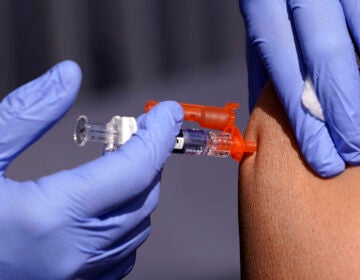Radon could be an invisible lung cancer risk inside your Pennsylvania home
Roughly 40% of Pennsylvania homes are estimated to have elevated levels of radioactive radon, according to the state.
Listen 1:03
Homes adjacent to Interstate 95 in Philadelphia. (Kimberly Paynter/WHYY)
From Philly and the Pa. suburbs to South Jersey and Delaware, what would you like WHYY News to cover? Let us know!
If you’ve resolved to start 2025 on a healthy note, lung health advocates say watch out for an invisible risk that could be lurking in your basement: radon.
Radon is a radioactive gas that can cause lung cancer. It comes from decaying uranium, which occurs naturally in soil and rocks, and can enter homes through foundation cracks.
“Radon is very insidious,” said Kevin Stewart, director of environmental health at the American Lung Association. “It is colorless, odorless, tasteless — doesn’t cause any immediate symptoms … The only way to know what a radon level is in a house is to do a test.”
Radon is the second-leading cause of lung cancer after smoking, according to the Environmental Protection Agency. For nonsmokers, it’s the leading cause of lung cancer.
“It puts off radioactive material and it damages the DNA, causing lung cancer, if it causes the right mutation in the DNA,” said Arthur Frank, a professor emeritus of environmental and occupational health at Drexel University.
In Pennsylvania, roughly 40% of homes are estimated to have levels of radon above the EPA’s health guideline, according to the Pennsylvania Department of Environmental Protection. This puts Pennsylvania above the national average, according to an analysis by the American Lung Association.
“Pennsylvania just has slightly unique geology,” said Bob Lewis, radon program manager with the state DEP. “We just have some slightly higher uranium and thorium concentrations in the rocks across the Commonwealth, and we have the right amount of rainfall and the right amount of glaciation.”
Elevated radon in homes is less common in Delaware and New Jersey, according to the American Lung Association.
But experts recommend testing for radon no matter where you live.
“You can’t go by how high the number is in your neighbor’s house,” Stewart said. “The only way to know what’s in your house is to do a test.”
What to do if your home has high levels of radon
Do-it-yourself home radon tests are widely available at home improvement retailers and hardware stores, Lewis said. Pa. DEP officials also plan to give out free radon tests Saturday at the 2025 Pa. Farm Show.
You can also find certified testers and laboratories in a vetted directory on DEP’s website.
Testing is most effective during the winter heating season, Lewis said, because warm air moving through the home can pull more outside air in through the foundation.
If you find your home does have high radon levels, look for a certified professional to install a radon mitigation system that effectively vacuums air from beneath the basement or lowest floor and vents it away from the home.
If hiring a contractor is cost-prohibitive, Lewis says it is possible to do it yourself. The EPA recommends contacting your state radon office for guidance.
“Give us a call, and we can walk them through the process,” Lewis said.

Get daily updates from WHYY News!
WHYY is your source for fact-based, in-depth journalism and information. As a nonprofit organization, we rely on financial support from readers like you. Please give today.






